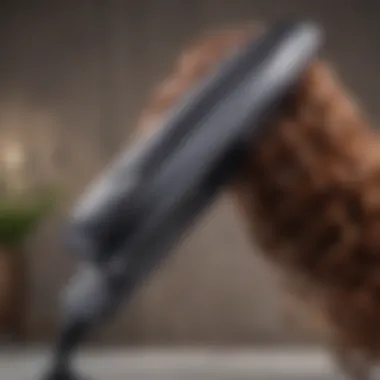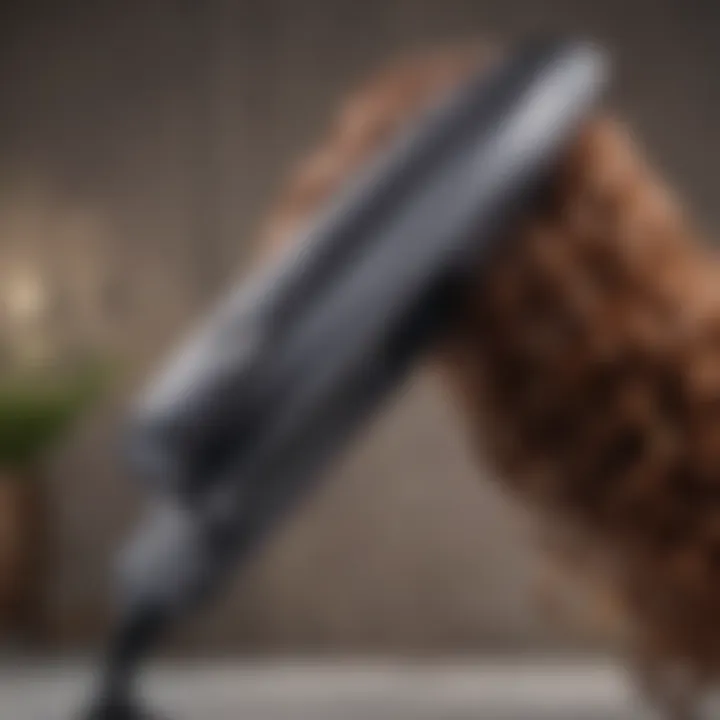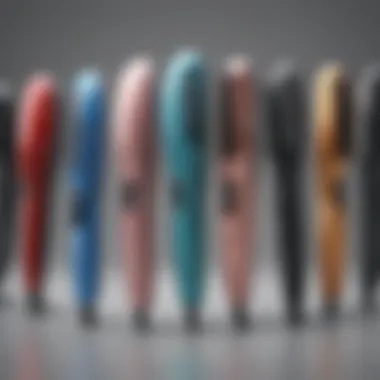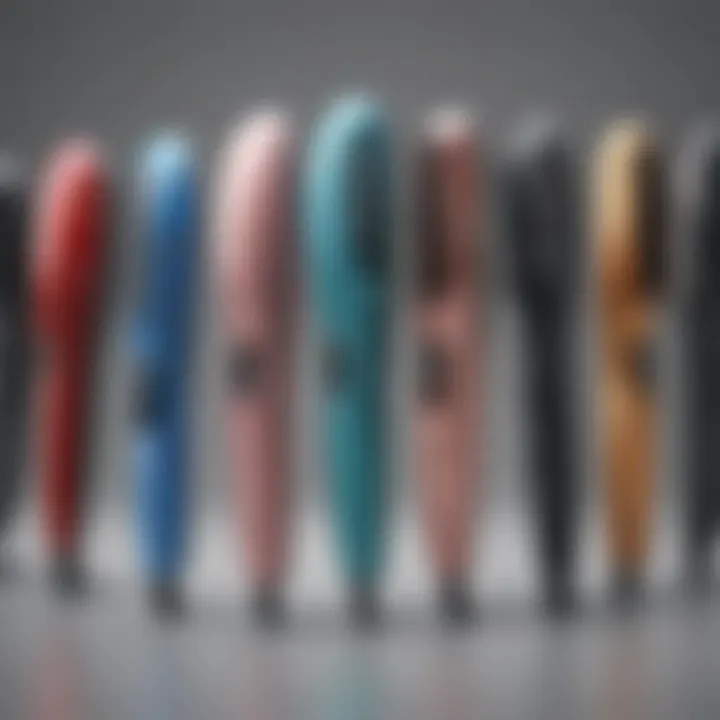Selecting the Best Hair Straighteners for Curly Hair


Intro
Curly hair presents unique challenges when it comes to styling. For many, achieving a sleek and straight look can feel like a daunting task. This need for effective solutions leads to a crucial question: what are the best tools to achieve the desired results, while also considering the health of the hair?
Selecting the optimal hair straighteners is not merely about aesthetics; it intertwines with maintaining hair integrity. With countless products available on the market, understanding the specific features that cater to curly hair becomes essential.
This article will dissect various options, focusing on the characteristics that allow these tools to excel in straightening curling textures. We will delve into the types of straighteners, comparing their specifications, advantages, and potential drawbacks. Furthermore, insights into factors like plate material, heat settings, and innovative technologies will be explored.
Ultimately, our aim is to provide readers with the knowledge necessary to make informed decisions regarding hair straighteners, while also offering strategies to preserve hair health during styling.
Understanding Curly Hair
Understanding curly hair is crucial when choosing the right hair straightener. Curly hair exhibits unique characteristics necessitating special considerations in both care and styling. Each curly hair type can differ significantly, influencing how it behaves when exposed to heat or different styling products. In-depth knowledge can empower individuals to make informed decisions, ensuring not only effective straightening but also minimizing potential damage.
Characteristics of Curly Hair
Curly hair usually has a distinct structure. The curls’ shape results from the way the hair follicle is angled and the variances in the hair’s protein structure. Curly hair tends to be drier than straight hair, as the natural oils produced by the scalp have a harder time traveling down the twisted strands. Furthermore, the curl pattern can vary immensely among individuals. Some have loose waves, while others exhibit tighter coils. Each pattern requires a different approach to straightening, particularly in terms of heat settings and techniques used.
"Curly hair, due to its structure, often requires tailored products and tools for optimal care and styling."
Challenges with Straightening Curly Hair
There are several obstacles faced when straightening curly hair. First, the natural bounce and volume of curls can be difficult to tame. Without proper techniques and the right tools, straightened hair can revert back to its curls shortly after styling. Additionally, high heat settings, if used improperly, can lead to significant damage, such as frizz, breakage, or dryness. Another challenge relates to moisture retention. Curly hair is naturally prone to dryness; thus, maintaining moisture while using heat is essential for achieving smooth results. This necessitates the use of heat protectants and aftercare products specifically designed for curly textures. The right hair straightener can make a substantial difference, ensuring that this process is effective and healthy.
Hair Straightener Technology
Hair straightener technology is a critical aspect to understand when selecting an appropriate tool, particularly for those with curly hair. The right technology can profoundly influence the effectiveness of straightening. It also affects hair health and the longevity of the style achieved. This section delves into crucial elements like plate materials and heat technology, which are key in determining how well the straightener will perform.
Understanding Plate Materials
Hair straighteners come with various plate materials, each offering distinct advantages and drawbacks. Choosing the right plate material can make a significant difference in the efficiency of straightening curly hair.
Ceramic Plates
Ceramic plates are known for their smooth surface and even heat distribution. They are celebrated for their ability to minimize damage while effectively straightening hair. This quality makes ceramic plates a popular choice among consumers. The high heat retention of ceramic plates allows for quick styling, reducing the time hair is exposed to heat. However, one should be cautious, as very high temperatures can still lead to potential heat damage if not monitored.
Titanium Plates
Titanium plates offer a different approach, characterized by their quick heating capability and high durability. They reach high temperatures efficiently, making them suitable for thicker hair types and more resistant textures. Titanium plates contribute to achieving a sleek finish with fewer passes through the hair. Despite these advantages, one must be careful with temperature settings, as a titanium plate may be too hot for finer textures, leading to damage if not used properly.
Teflon Coated Plates
Teflon-coated plates are specially designed to prevent hair from sticking to the iron, enhancing the overall experience of styling. This type of plate allows for a smoother glide, making it easier to style hair without snagging. Teflon is recognized for its non-stick properties, reducing the amount of heat required for effective styling. While this can be beneficial, Teflon coatings may wear off over time, potentially decreasing the performance of the straightener.


Heat Technology
Besides plate materials, heat technology is essential to evaluate when choosing a hair straightener. The heating method and features available can significantly impact the results achieved on curly hair.
Infrared Heating
Infrared heating is a technology that emits longer wavelengths of heat. This method penetrates the hair shaft more deeply, ensuring that styling is done quickly without excessive heat on the outer layer of the hair. The primary advantage of this approach is the reduction of damage, as it uses lower temperatures effectively. The downside could be that infrared heat might not work equally well on all hair types, requiring some adjustment.
Steam Technology
Steam technology uses moisture in the form of steam during the straightening process. This method helps to prevent frizz and adds hydration, making it particularly suitable for curly hair prone to dryness. The key benefit is that your hair maintains its moisture balance, ultimately leading to healthy-looking straight styles. However, one must ensure the steam technology is of good quality, as poor designs can lead to excessive water exposure and potential hair damage.
Adjustable Temperature Control
Adjustable temperature control allows users to customize the heat level to their specific hair type and condition. This flexibility is essential for achieving optimal results, especially with curls that can vary significantly in texture. A key advantage is that it accommodates various user preferences, promoting safer styling practices. Nevertheless, it can be overwhelming for some users to determine the ideal temperature settings, thus requiring informed decisions and possibly a bit of experimentation.
Key Features to Consider
When selecting a hair straightener, especially for curly hair, certain features become paramount. These key elements determine not only the effectiveness of straightening but also the health of your hair in the process. Understanding each feature allows for a more tailored decision, ensuring that the straightener chosen meets specific hair needs.
Plate Width
The width of the plates is crucial in achieving the desired results. For individuals with curly hair, wider plates often prove beneficial. A straightener with plates that are at least 1.5 inches wide allows for larger sections of hair to be straightened at once. This efficiency can cut down styling time significantly. Narrower plates, while useful for precision styling or bangs, may require more passes through thicker or coarser curls, leading to increased exposure to heat.
It is important also to consider the type of curls. If your curls are tight and voluminous, wider plates provide better coverage. On the other hand, individuals with loose waves may find that narrower plates work sufficiently. Ultimately, selecting the right plate width can enhance the straightening process and yield smoother results.
Cord Length and Type
The type and length of the cord may seem like minor factors, but they can greatly influence the convenience and comfort of using a hair straightener. A longer cord, typically around nine feet or more, allows easier maneuverability, enabling users to move around freely without the constraints of a short cable. This is especially handy for those with large mirrors or when styling in different areas of the home.
Additionally, the type of cord is worth noting. A swivel cord is highly recommended. This design prevents tangling and allows for more natural movement during styling. A straightener equipped with a swivel cord enhances the overall user experience by reducing frustration while maneuvering the tool.
Weight and Design
The weight and overall design of a hair straightener play a prominent role in user experience. A lightweight model allows for extended use without causing fatigue. This can be particularly important for individuals who may need to straighten their hair on a regular basis. Conversely, a very heavy straightener might lead to discomfort, making styling a tedious process.
Design is also a factor. Ergonomically designed straighteners offer a better grip, ensuring that users can handle the device comfortably while maintaining control. A model that fits nicely in the hand can aid in achieving smoother results and can prevent slipping, which is crucial when working through curly hair.
In summary, the features of plate width, cord length and type, and weight and design are integral to selecting an optimal hair straightener for curly hair. These elements affect not only the efficiency of the straightening process but also the overall experience and time spent styling. Taking the time to evaluate these features may lead to better styling outcomes and healthier hair.
Top Hair Straighteners for Curly Hair
Choosing the right hair straightener is essential for individuals with curly hair. The effectiveness of straightening depends not only on the device but also on how well it caters to the unique needs of curly textures. This section will explore various products that excel in straightening curly hair, each with their specific features and benefits. Key elements to consider include the straightener's heating technology, plate materials, and design, which all play a crucial role in achieving smooth and sleek results.
Product One: Features and Benefits


The first product to consider is the ghd Platinum+ Hair Styler. This straightener utilizes predictive technology that recognizes hair thickness and styling speed. Therefore, it maintains the optimal styling temperature of 365°F, minimizing heat damage.
Key features include:
- Ultrafast Heating: The straightener heats up in just 20 seconds, ensuring quick styling.
- Automatic Sleep Mode: It turns off after 30 minutes of inactivity for safety.
- Versatile Plate Design: This design works for any hair type, but it drastically benefits curly hair by providing an even distribution of heat.
Benefits include:
- Reduced frizz and static due to the innovative plate technology.
- Long-lasting style that withstands humidity, ensuring your hair stays straight throughout the day.
Product Two: Features and Benefits
The second option is the Babylisspro Nano Titanium Straightening Iron. This straightener combines titanium plates with high heat settings.
Key features consist of:
- Extensive Temperature Range: It can reach up to 450°F, providing flexibility for different hair types.
- Lightweight Design: Its ergonomic build makes it easy to handle during styling sessions.
- Nano Titanium Technology: This unique technology allows faster heat transfer and ensures even heating.
Benefits include:
- Great for thick, coarse curly hair that often requires higher heat settings to achieve straightness.
- Smooth gliding plates that reduce pulling and breakage, thus promoting healthier hair.
Product Three: Features and Benefits
Finally, consider the Remington S5500 Digital Anti-Static Hair Straightener. This product offers efficient straightening at an affordable price.
Key features include:
- Ceramic Plates: Helps in reducing static while providing a shiny finish.
- Digital Temperature Control: This control allows users to adjust settings according to their hair type, ranging from 310°F to 450°F.
- Quick Heat Up: The straightener reaches the desired temperature in just 30 seconds.
Benefits involve:
- Excellent for those who are budget-conscious but still want a quality tool for styling.
- The anti-static feature ensures a smooth result without frizz, ideal for maintaining the integrity of curly hair.
Selecting the right straightener not only enhances hair aesthetics but also promotes better hair health.
In summary, choosing a top straightener for curly hair means assessing not only the device's capabilities but also understanding your specific hair needs. Each of these products offers unique advantages, making them suitable options for achieving straight hair without compromising health.
Hair Care Considerations
When it comes to straightening curly hair, understanding hair care considerations is crucial. Heat styling can affect the hair's integrity if not done properly. Therefore, factors such as using heat protectants, maintaining moisture balance, and adopting post-straightening care practices play significant roles in preserving the health of curly hair.
Using Heat Protectants
Before applying any heat styling tool, heat protectants are essential. They form a protective barrier between your hair and the heat, minimizing damage. Heat protectants come in various forms, including sprays, creams, or serums, and should be applied evenly through damp or dry hair. Their active ingredients shield the hair cuticle from extreme temperatures. Additionally, heat protectants often include nourishing elements that can enhance your hair's shine and smoothness.


Maintaining Moisture Balance
Curly hair tends to be more prone to dryness, so maintaining moisture balance is vital. When hair lacks moisture, it becomes brittle and susceptible to breakage. After using a straightener, a deep conditioning treatment can help restore hydration. Products with natural oils, such as argan or coconut oil, can be particularly effective. Incorporating a regular hair oiling routine may also help lock in moisture, promoting healthier hair overall. Pay careful attention to using conditioner, especially a leave-in variant, as part of your daily regimen.
Post-Straightening Care
After you finish straightening your curls, your hair requires proper care to maintain its health. Avoid washing your hair too soon after styling, as this can strip natural oils. Instead, wait at least 48 hours to allow the straightening to settle. It's also wise to avoid excessive heat styling until your hair fully recovers. Incorporating a light serum can help tame any flyaways and add a finishing touch to your hairstyle. Lastly, consider regular trims to remove split ends, making your hair look healthier and more vibrant.
In summary: Protecting your hair from heat, ensuring proper moisture levels, and implementing aftercare routines are crucial to maintaining the health and appearance of curly hair.
Common Myths about Hair Straightening
Hair straightening can be a source of confusion, especially for those with curly hair. This section aims to debunk some common myths surrounding the practice, providing a clearer understanding of what truly affects curly hair during the straightening process. The significance of addressing these myths lies in preventing misinformation that can lead to damage and disappointment. By understanding the realities behind hair straightening, individuals can make informed decisions that promote healthier hair and maximize the effectiveness of their styling tools.
Myth One: Heat Will Ruin All Curly Hair
One prevalent belief is that the application of heat will inevitably damage all types of curly hair. While it is true that excessive heat can lead to dryness and breakage, this myth does not consider the nuances of proper heat styling techniques. Curly hair can be straightened without suffering irreversible damage when important steps are followed.
Firstly, investing in a high-quality hair straightener can significantly minimize risk. Straighteners equipped with advanced technology, such as adjustable temperature settings, allow users to tailor heat application to fit their specific hair type. This is crucial, as thicker or denser curls may withstand higher temperatures compared to finer textures.
Moreover, the use of heat protectants creates a barrier, safeguarding the hair from direct heat exposure. Protective products can prevent moisture loss and help maintain the hair's natural integrity. Therefore, with the right approach and tools, heat can be applied safely without compromising the quality of curly hair.
Myth Two: All Straighteners Are the Same
Another common misunderstanding is that all hair straighteners deliver identical results, which can lead to poor choices in tools. In reality, straighteners vary widely in their plate materials, technology, heat settings, and overall design, which significantly influences their effectiveness, particularly for curly hair.
Ceramic plates, for instance, provide even heat distribution and are less likely to cause hot spots, which can lead to damage. In contrast, titanium plates heat up quickly and may be suitable for thicker, coarser curls but can be damaging if not used wisely. The presence of additional technologies, such as steam or infrared heating, can also offer distinct advantages for particular hair types.
When selecting a straightener, it is essential to consider how its specifications match the unique requirements of curly hair. A thorough understanding of these differences can prevent the choice of an unsuitable tool, reducing the risk of experiencing unsatisfactory straightening results.
Choosing the right hair straightener is key for maintaining the health and appearance of curly hair while achieving desired styling results.
Final Thoughts on Choosing Hair Straighteners
When selecting a hair straightener, especially for curly hair, it is essential to carefully consider various factors. With the vast array of options available, the process can become overwhelming. Yet, understanding personal needs and budget limitations can aid considerably in making a well-informed decision. This section highlights the importance of aligning personal preferences with product features.
Evaluating Personal Needs
Every individual has unique hair characteristics and styling preferences. Assessing your specific needs is the first step in choosing the right hair straightener.
- Hair Type: Curly hair varies significantly in texture and thickness. Consider if your curls are tight, loose, coiled, or wavy. This understanding will guide the choice of plate material and width.
- Usage Frequency: Reflect on how often you intend to straighten your hair. Frequent use might necessitate a straightener with advanced technology to minimize heat damage.
- Desired Style: Different straighteners can achieve different looks, from sleek and straight to more relaxed waves. Determine what end style you prefer. This can influence the choice of heat settings and plate width.
- Hair Health: If your hair has suffered from heat styling in the past, look for models that include protective features, such as adjustable temperatures or steam infusion.
In essence, evaluating these factors can lead to an optimal purchase that enhances hair aesthetics while promoting health.
Budget Considerations
Budget is a significant factor when considering a hair straightener. There is a wide pricing range in the market, but the criteria below can assist in making a sound financial decision:
- Quality vs. Cost: Aim for a balance between performance and budget. Often, low-cost models lack critical features that can protect and style your hair effectively. Investing in a mid-range or high-end model can provide better longevity and results.
- Brand Reputation: Researching brands can provide insights into reliability and customer satisfaction. Respected labels often offer better customer service and warranty options.
- Sales and Discounts: Search for deals or seasonal sales. Many retailers provide discounts that can make premium straighteners more affordable.
- Long-term Investment: Consider the straightener as an investment. A quality tool may be pricier initially but can save money in the long run through reduced need for hair salon visits or replacements.
In summary, thought-out budget considerations not only protect your finances but also guide you to a more suitable straightening device.







